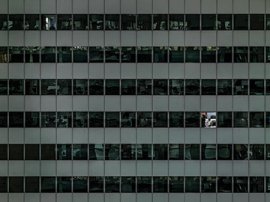
Recent space articles
 Artwork: Michael Wolf, The Transparent City 93, 2008, France
Artwork: Michael Wolf, The Transparent City 93, 2008, France
In Silicon Valley the tight correlation between personal interactions, performance, and innovation is an article of faith, and innovators are building cathedrals reflecting this. Google’s new campus is designed to maximize chance encounters.
Facebook will soon put several thousand of its employees into a single mile-long room. Yahoo notoriously revoked mobile work privileges because, as the chief of human resources explained, “some of the best decisions and insights come from hallway and cafeteria discussions.” And Samsung recently unveiled plans for a new U.S. headquarters, designed in stark contrast to its traditionally hierarchical culture. Vast outdoor areas sandwiched between floors will lure workers into public spaces, where Samsung’s executives hope that engineers and salespeople will actually mingle. “The most creative ideas aren’t going to come while sitting in front of your monitor, ” says Scott Birnbaum, a vice president of Samsung Semiconductor. The new building “is really designed to spark not just collaboration but that innovation you see when people collide.”
Faith is nice, but do executives have proof that this works? Social space like Samsung’s could be just another in a long line of fads and broken promises in workspace design: The “action office” becomes the cubicle. Cubicles are torn down for open plans, which leave introverts pining for private space. Quads. Hotel space. Couches. Rotating desk assignments. Standing desks. Treadmill desks. No desks. With apologies to Mark Twain, there’s no such thing as a new office design. We just take old ideas, put them into a kind of kaleidoscope, and turn.
How do we know whether any of these approaches is effective? The key metric companies use to measure space—cost per square foot—is focused on efficiency. Few companies measure whether a space’s design helps or hurts performance, but they should. They have the means. The same sensors, activity trackers, smartphones, and social networks that they eagerly foist on customers to reveal their habits and behavior can be turned inward, on employees in their work environments, to learn whether it’s true that getting engineers and salespeople talking actually works.
Emerging Evidence
We’ve already begun to collect this kind of performance data using a variety of tools, from simple network analytics to sociometric badges that capture interaction, communication, and location information. After deploying thousands of badges in workplaces ranging from pharmaceuticals, finance, and software companies to hospitals, we’ve begun to unlock the secrets of good office design in terms of density, proximity of people, and social nature. We’ve learned, for example, that face-to-face interactions are by far the most important activity in an office. Birnbaum is on to something when he talks about getting employees to “collide, ” because our data suggest that creating collisions—chance encounters and unplanned interactions between knowledge workers, both inside and outside the organization—improves performance.
Chance encounters and interactions between knowledge workers improve performance.
We’ve also learned that spaces can even be designed to produce specific performance outcomes—productivity in one space, say, and increased innovation in another, or both in the same space but at different times. By combining the emerging data with organizational metrics such as total sales or number of new-product launches, we can demonstrate a workspace’s effect on the bottom line and then engineer the space to improve it. This will lead to profound changes in how we build our future workspaces. Here are a few:
Recognize office space as not just an amortized asset but a strategic tool for growth.
The consulting and design firm Strategy Plus estimates that office utilization peaks at 42% on any given day. By that logic, the best way to manage cost per square foot is to remove “wasted” square feet. But the data we’re generating reveal that investments in re-engineering space for interactions over efficiency can increase sales or new-product launches.
Design offices to reflect how 21st-century digital work actually happens.
The buildings we go to every day haven’t changed as much as have the tools we use to get work done. Merging digital communication patterns with physical space can increase the probability of interactions that lead to innovation and productivity.
Re-engineer offices to weave a building, a collection of buildings, or a variety of workspaces into the urban fabric.
The office of the future will most likely include highly networked, shared, multipurpose spaces that redefine boundaries between companies and improve everyone’s performance.
Getting there won’t be easy. It will require collecting much more data to inform new design and management principles while engaging urban planners and municipal governments. It will also transform HR, IT, and facilities management from support functions to facilitators. But if companies can change their spaces to reflect how people work, performance improvement will follow. Don’t take that on faith. There are data to prove it.
Strategic Coffee Machines
Jon Fredrik Baksaas, the CEO of the Norwegian telecommunications company Telenor, credits the design of the company’s Oslo headquarters with helping it shift from a state-run monopoly to a competitive multinational carrier with 150 million subscribers. That design, he says, improved communication, accelerated decision making, and even created what he calls “an attacking mind-set.” It was ahead of its time in 2003, when it incorporated “hot desking” (no assigned seats) and spaces that could easily be reconfigured for different tasks and evolving teams.
Telenor’s CEO thinks of its headquarters not as real estate but as a communication tool.
The design features that make the space effective resulted from a profound shift in mind-set: Baksaas thinks of the offices not as real estate but as a communication tool. Thus strategy, features, and value become more important than cost and efficiency. You’d choose the e-mail provider with the best collaboration and file-transfer features; you can think of space investments the same way.
The improved communication Telenor achieved in its new space can be explained by Alex “Sandy” Pentland’s April 2012 HBR article, “The New Science of Building Great Teams.” Pentland deployed badges (the same kind now used by Ben Waber’s firm) that track how people talk to one another, who talks with whom, how people move around the office, and where they spend time. (Devices were worn on an opt-in basis, and individual data were anonymous and unavailable to employers.) Pentland identified three key elements of successful communication: exploration (interacting with people in many other social groups), engagement (interacting with people within your social group, in reasonably equal doses), and energy (interacting with more people overall).
Spaces designed to promote these activities increase the likelihood of collisions—and the data repeatedly demonstrate that more collisions create positive outcomes. We don’t measure the content of interactions, but that doesn’t matter. When collisions occur, regardless of their content, improvement typically follows.

















